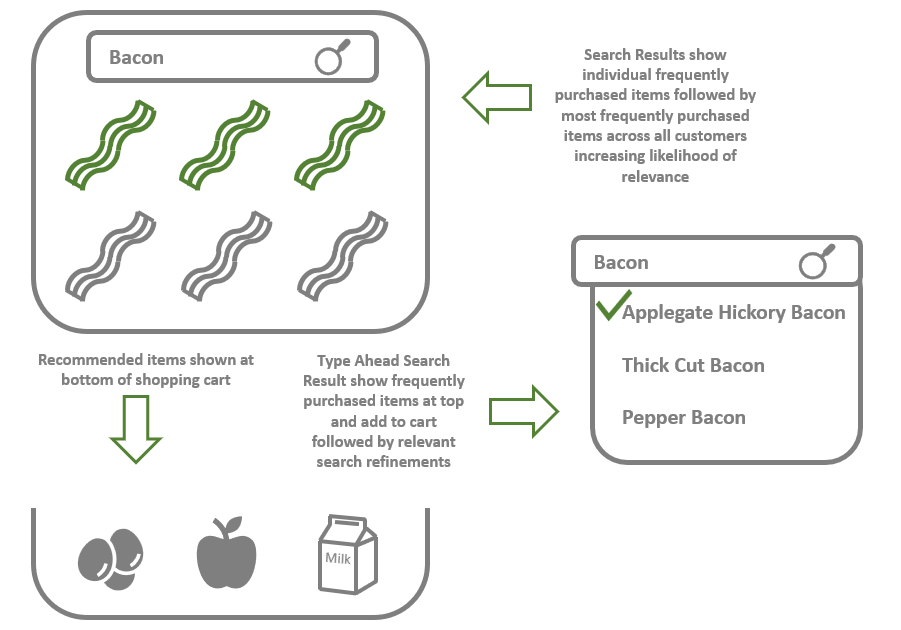Dynamic Assortments in Online Grocery Shopping
Assortments are fixed in a grocery store. You understand the demographics of the customers and tailor the assortment to the averages for the store, but once it’s done it’s fixed for all customers that visit that store. Online that’s not the case and you can customize assortments to what customers are most likely to buy or what you want to promote. Customized assortments are also a way for vendors to most effectively spend their ad dollars because customers see their products when it’s relevant. It’s better for the customer, better for you as the grocer, and better for the vendors pushing their products.
We used a tool called Bloomreach to customize the search results in different ways:
- Dynamic Search Results: Through Bloomreach, you can send search requests to the engine and your own catalog which then returns a dynamic list of what the customer is most likely to buy. We added the most frequently purchased items to the top of search results to fully customize the results.
- Type Ahead Search: With type ahead search, you’re limited to at most 10 to 15 keywords. We experimented with using the top 3 most frequently purchased items followed by promoted or relevant keywords.
- Recommendations: Based on search history and purchase history, Bloomreach would recommend items that were relevant to the customer.

The old way of presenting items to customers through a standard catalog taxonomy is dead. We used to joke that we didn’t need a website anymore. All we really needed was a search bar because 80% of the time customers would simply go to the search and bypass everything else on the site. So props to Google for simply showing a search bar when you go to their site.
Now, we can’t really do that because it would drive the merchandisers crazy! They still cling to the belief that beautiful images sell products. And they are partially right, but how many beautiful images are needed? With heatmap functionality, we could see as you traverse the page, purchases fall off fast. What customers can see on the page under the search bar is viewed 100% of the time, but then drops off quickly on the next scrollable section until it’s almost non-existent further down the page.
Notice I said purchases, not views. When we studied behavior, it was obvious we had two distinct audiences: new customers and existing customers. New customers wanted to browse, but they didn’t purchase as frequently or as much and existing customers wanted efficiency. Satisfying both of these competing needs was a challenge.
When you get to know the customer through their purchase history, you can provide a much better experience with more relevant products. But you can also use aggregate history across all customers to recommend products which is what you do with new customers. We tested multiple ways of changing the assortment with Bloomreach ultimately ending up with search results that improved conversion rates. We also used a tool called Criteo to intersperse relevant sponsored items throughout the search results for additional ad revenue.
K3Group can help you improve your customer experience with similar techniques leading to an increased order value and improved conversion rates.
Explore More on Online Grocery Shopping Insights
- Grocery Item Search Suggestions – Learn how to enhance user experience with smart search suggestions in online grocery.
- Dynamic Assortments in Online Grocery Shopping – Discover the benefits of tailoring product assortments to meet shopper preferences.
- Building a Grocery Cart Faster – Explore strategies to streamline the cart-building process for faster, more convenient shopping.
- Online Grocery Shopping Channel Analysis – Analyze key trends and performance across different online grocery channels.
- Insights on Grocery Online Shopping Behavior – Gain insights into consumer behavior to inform your online grocery strategy.
